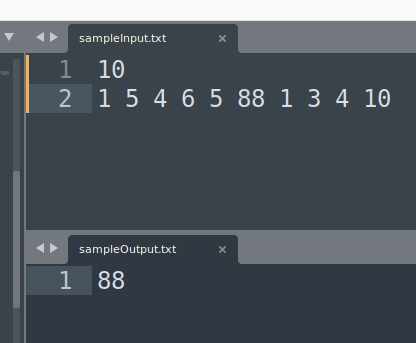Test case format
This article contains information about test cases in programming questions and sample test cases for a sample programming question.
Type of test cases required
Every programming question needs test cases. At HackerEarth, we recommend a minimum of 10 test cases that cover various corner cases for a specific problem statement. The format of the test case file should follow the given condition:
- There must be exactly 10 test cases for each problem.
- The total score of the test cases must be 100.
- Suppose the answer to any problem is a single integer or a single character, then it must have multiple test cases.
- The size of an individual test case should not exceed 8 MB.
These test cases can be divided as follows:
Easy test cases
Easy test cases should meet these conditions.
|
Features of the test case |
Example |
Score |
|
Add two Easy test cases. Recommendation: The first two Easy test cases should be made visible to candidates |
If you have an array with size n equal to 10^5 constraints, then your n value should be less than equal to 10. Problem Constraint
Test Case Constraint
|
If the total score of your question is 100, then your Easy test cases should have a score of 5 each
|
|
The constraint size should be minimal as possible |
||
|
The brute force approach can be used to solve the test case |
||
|
A candidate should be able to solve this test case manually |
Medium test case
Medium test cases should meet these conditions.
|
Features of the test case |
Example |
Score |
|
Add three Medium test cases |
If you have an array with size n equal to 10^5 constraints, then your n value should be less than equal to 10^3 Problem Constraint
Test Case Constraint
|
If the total score of your question is 100, then your Medium test cases should have a score of 5 each
|
|
These test cases should cover corner cases related to the algorithm being used |
||
|
A candidate should be able to solve these test cases in the most optimal manner. |
Hard test cases
Hard test cases should meet these conditions.
|
Features of the test case |
Example |
Score |
|
Add five Hard test cases |
If you have an array with size n equal to 10^5 constraints, then your n value should be less than equal to 10^5. Problem Constraint
Test Case Constraint
|
If the total score of your question is 100, then your Hard test cases should have a score of 15 each
|
|
These test cases are aimed at checking if candidates can solve the problem in the most optimal manner |
||
|
The constraint size should be as exhaustive as possible |
||
|
Only the correct algorithm or approach can be used to solve the test case |
Generating test cases
Generate test cases that are compatible with the auto-generated code snippets. For example, assume that you are creating test cases for this problem statement:
Write a program to find the highest/maximum number in an array.
Sample input and sample output
The input and output for this problem statement will be as follows:

Explanation
- Here 10 in the first line of the sample input signifies the number of elements in the array
- The second line of the sample input signifies 10 elements in the array, separated by spaces
- The sample output only contains the answer that is the highest/maximum number in the array
So, go through the auto-generated code snippets first and then generate the test cases accordingly so that you don’t have to change the auto-generated code snippets afterward.
This is how you can easily create test cases for programming questions for various difficulties.
Solution for the example problem in C++

Code to create random test cases in C++ in your local system
